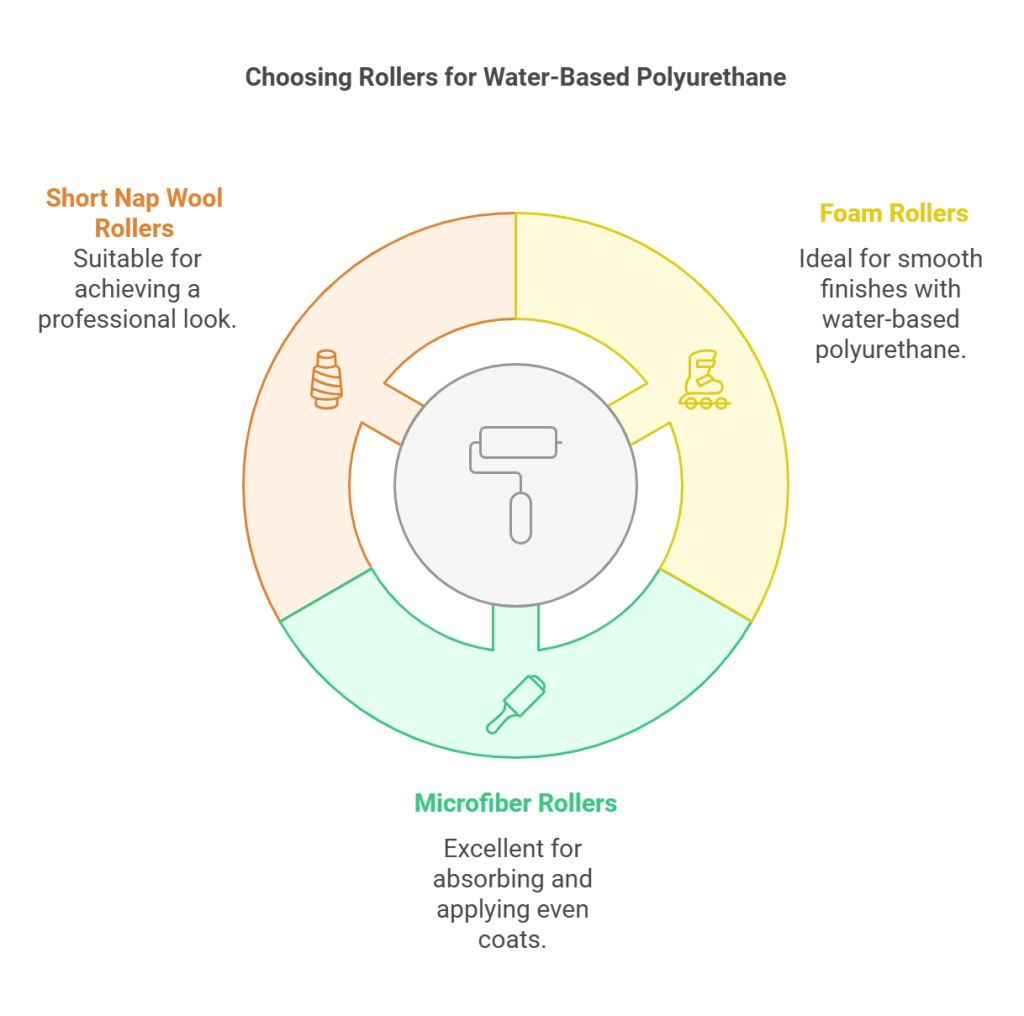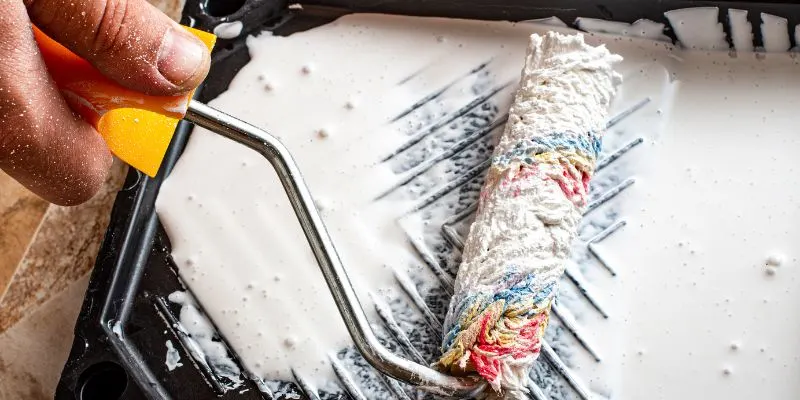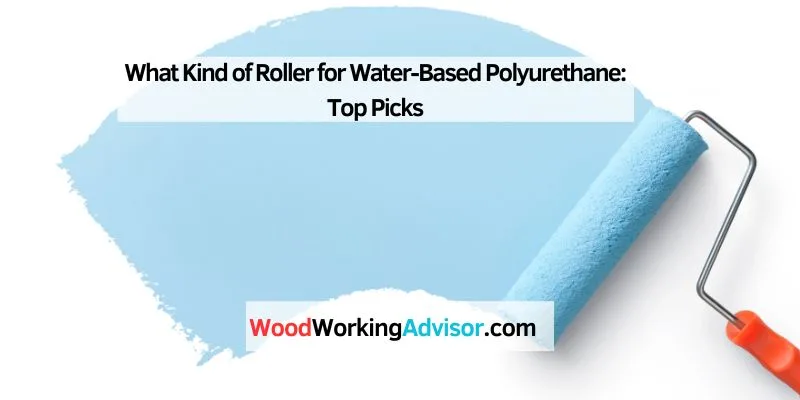Use a high-quality, microfiber roller for applying water-based polyurethane. A ¼ to ½ inch nap length is ideal for smooth finishes.
Choosing the right roller for water-based polyurethane is essential for achieving a flawless finish. A microfiber roller ensures even application and minimizes bubbles, which can mar your project. These rollers absorb and release the product efficiently, allowing for better control.
The right nap length, typically between ¼ and ½ inch, helps cover surfaces without leaving excessive texture. This ensures that the final coat appears smooth and professional. Using the correct roller not only improves aesthetics but also enhances durability, making your wood surfaces more resilient. Investing time in selecting the right tools leads to superior results and a more satisfying DIY experience.
Introduction To Water-based Polyurethane
Water-based polyurethane is a clear finish for wood surfaces. It protects against scratches and stains. This type of finish dries quickly and has low odor. Many homeowners prefer it for interior projects.
Benefits Of Water-based Polyurethane
- Fast Drying Time: Dries within hours, allowing quick project completion.
- Low Odor: Emits fewer fumes than oil-based alternatives.
- Easy Cleanup: Cleans up with soap and water, no harsh chemicals needed.
- Environmentally Friendly: Contains fewer harmful substances.
- Flexible Application: Can be used on various surfaces like wood, metal, and more.
Comparing Water And Oil-based Polyurethane
| Feature | Water-Based Polyurethane | Oil-Based Polyurethane |
|---|---|---|
| Drying Time | Fast, usually 1-2 hours | Slow, often 8-24 hours |
| Odor | Low | High |
| Cleanup | Soap and water | Solvents required |
| Durability | Good, but less than oil-based | Very durable |
| Color Yellowing | Less yellowing over time | More yellowing over time |
Key Factors In Choosing A Roller
Choosing the right roller for water-based polyurethane is crucial. The right choice affects the finish and ease of application. Here are the key factors to consider:
Material And Texture
Roller materials and textures greatly influence the finish quality. Common materials include:
- Nylon: Great for smooth finishes.
- Polyester: Suitable for all types of surfaces.
- Foam: Ideal for small projects and fine details.
Texture also matters. A smooth texture works for a flat finish. A textured roller creates a more pronounced look.
Size Matters
Roller size affects how quickly you cover a surface. Common sizes include:
| Size | Best For |
|---|---|
| 4 inches | Small areas or corners |
| 9 inches | Medium to large areas |
| 12 inches | Large surfaces and floors |
Choose a size that fits your project. Larger rollers cover more area quickly.
Roller Nap Length
Roller nap length affects the finish texture. Here’s a simple guide:
- Short nap (1/4 inch): Best for smooth surfaces.
- Medium nap (3/8 inch): Good for semi-smooth surfaces.
- Long nap (1/2 inch or more): Works well on rough surfaces.
Pick the nap length based on your surface type. A shorter nap gives a finer finish. A longer nap adds texture.

Top Roller Picks For Water-based Polyurethane
Choosing the right roller is vital for applying water-based polyurethane. The right roller can ensure a smooth finish and reduce bubbles. Here are the best roller options for your project.
Foam Rollers
Foam rollers are popular for applying water-based polyurethane. They provide a smooth and even coat. Here are some key features:
- Easy to use
- Minimize bubbles
- Good for small areas
Consider these top foam rollers:
| Brand | Size | Features |
|---|---|---|
| Wooster | 4-inch | High-density foam, great for detailed work |
| Richard | 9-inch | Durable and washable, ideal for larger surfaces |
Microfiber Rollers
Microfiber rollers are another excellent choice. They hold more paint and deliver a smooth finish. Here are some benefits:
- High absorption rate
- Less lint
- Good for large areas
Top picks include:
- ProForm Microfiber Roller – 9-inch, extra absorbent
- Purdy Marathon – 4-inch, perfect for tight spaces
Short Nap Wool Rollers
Short nap wool rollers are great for achieving a professional finish. They work well with water-based products. Key features include:
- Excellent for smooth surfaces
- Durable and long-lasting
- Good for larger projects
Recommended options are:
| Brand | Size | Features |
|---|---|---|
| Purdy | 9-inch | High-quality wool, smooth finish |
| Wooster | 6-inch | Ideal for trim and small areas |
Expert Recommendations
Choosing the right roller for water-based polyurethane is crucial. The right tools enhance the finish and efficiency of your project. Here are expert recommendations tailored for both professional painters and DIY enthusiasts.
Professional Painters’ Choices
Experienced painters prioritize quality. They often select rollers that offer smooth application and minimal texture. Here are some top choices:
| Roller Type | Best Use | Key Features |
|---|---|---|
| High-Density Foam Roller | Smooth finishes on flat surfaces | Minimal lint, excellent absorption |
| Microfiber Roller | Textured surfaces | Durable, good paint pickup |
| Short Nap Roller | Small areas and trim | Fine finish, less stipple |
DIY Enthusiast Favorites
DIYers seek affordability and ease of use. They prefer rollers that provide good results without breaking the bank. Here are popular picks:
- Foam Roller: Great for small projects and touch-ups.
- 9-inch Roller: Perfect for walls and large surfaces.
- 9mm Nap Roller: Ideal for slightly textured surfaces.
Consider these factors for your roller choice:
- Surface type: Choose based on smoothness or texture.
- Roller material: Foam or microfiber for different finishes.
- Nap length: Short nap for smooth, long nap for texture.
Application Tips For A Smooth Finish
Applying water-based polyurethane can be tricky. Proper technique ensures a beautiful finish. Here are essential tips for a smooth application.
Prepping Your Surface
Before applying polyurethane, surface preparation is vital. Follow these steps:
- Clean the Surface: Remove dust, dirt, and grease.
- Sanding: Sand the surface to create a smooth base.
- Remove Dust: Use a vacuum or a tack cloth.
- Test Area: Apply a small amount first to check compatibility.
Proper prep helps the polyurethane adhere well. A clean and smooth surface prevents imperfections.
Technique For Even Application
Using the right technique makes a big difference. Follow these tips for even application:
- Choose the Right Roller: Use a roller with a short nap.
- Load the Roller: Dip and roll to remove excess.
- Apply in Sections: Work in small areas at a time.
- Use Light Pressure: Let the roller do the work.
- Cross-Hatch Technique: Apply in one direction, then the opposite.
This method helps avoid bubbles and streaks. A smooth finish enhances the overall look.

Common Mistakes To Avoid
Using water-based polyurethane can be tricky. Avoiding common mistakes helps achieve a smooth finish. Here are two major pitfalls to steer clear of.
Overloading The Roller
Overloading the roller leads to drips and uneven coats. Use the right amount of product for best results. Here are some tips:
- Dip the roller lightly into the polyurethane.
- Roll it on the tray to remove excess.
- Apply thin layers for a smooth finish.
Too much product can cause:
- Drips that ruin your work.
- Longer drying times.
- Uneven surfaces.
Skipping Sanding Between Coats
Sanding between coats is crucial for a smooth finish. It helps the next layer adhere properly. Here’s what to do:
- Allow the first coat to dry completely.
- Use fine-grit sandpaper (220 grit is ideal).
- Sand lightly to create a smooth surface.
- Clean the surface before applying the next coat.
Skipping this step can lead to:
- Poor adhesion of the next coat.
- Visible imperfections on the surface.
- A rough, uneven texture.
Maintenance And Cleaning Of Rollers
Keeping your rollers clean is essential. Proper maintenance extends their life. It ensures the best results when applying water-based polyurethane. Follow these steps to maintain and clean your rollers effectively.
Cleaning Steps
Cleaning your rollers after use is vital. Here’s a simple guide:
- Remove excess polyurethane: Use a paint scraper or your hands.
- Wash with warm soapy water: Use a bucket with warm water and mild soap.
- Rinse thoroughly: Ensure all soap is removed from the roller.
- Shake off excess water: Gently shake or roll the roller to remove water.
- Dry completely: Hang the roller or place it on a clean towel.
Following these steps will keep your rollers in good condition. Clean rollers provide a smoother finish. Avoid using solvents as they can damage the roller fabric.
Storage For Longevity
Proper storage extends the life of your rollers. Here are some tips:
- Store in a cool, dry place: Avoid heat and moisture.
- Keep in original packaging: This protects the roller shape.
- Avoid stacking heavy items: This can deform the rollers.
- Use a roller cage: This keeps them organized and prevents damage.
By maintaining and storing your rollers correctly, you ensure optimal performance. Regular care makes your painting projects easier and more enjoyable.
Conclusion: Enhancing Your Project With The Right Tools
Choosing the right roller for water-based polyurethane can make a big difference. The right tools improve your finish and save time. Let’s recap the best roller options and highlight key points for a smooth application.
Recap Of Top Roller Picks
| Roller Type | Material | Best For |
|---|---|---|
| Foam Roller | High-Density Foam | Flat surfaces, smooth finish |
| Nap Roller | Polyester | Rough surfaces, better coverage |
| Microfiber Roller | Microfiber | Detailed work, fine finish |
Foam rollers create a smooth finish. Choose nap rollers for textured surfaces. Microfiber rollers are great for detailed work. Each roller has its unique benefits.
Final Thoughts On Achieving A Professional Finish
Using the right roller is essential for the best results. A proper roller helps avoid bubbles and streaks. Here are some tips:
- Clean the surface before applying polyurethane.
- Use long, even strokes for a smooth application.
- Work in sections to maintain a wet edge.
- Allow proper drying time between coats.
Investing time in choosing the right roller enhances your project. A professional finish is possible with the right tools and techniques.
Frequently Asked Questions
What Type Of Roller Is Best For Polyurethane?
For water-based polyurethane, a high-density foam roller is recommended. It provides a smooth finish and minimizes bubbles. Choose a roller with a ¼-inch nap for even application. This ensures the polyurethane spreads evenly without leaving streaks or marks.
Can I Use A Paintbrush Instead Of A Roller?
Yes, you can use a paintbrush for water-based polyurethane. However, a roller is often more efficient for larger areas. Brushes are ideal for corners and edges. Using both tools can help achieve the best finish and coverage.
How Do I Clean Rollers After Using Polyurethane?
Clean rollers immediately after use to avoid hardening. Rinse them thoroughly with warm, soapy water. Use a brush to remove any remaining polyurethane. Ensure they are completely dry before storing to maintain their shape and effectiveness.
Should I Thin Water-based Polyurethane Before Rolling?
Thinning is generally not necessary for water-based polyurethane. However, if the product is too thick, you can add a small amount of water. Always consult the manufacturer’s instructions for specific recommendations on thinning.
Conclusion
Choosing the right roller for water-based polyurethane is crucial for achieving a smooth finish. Opt for a high-quality, synthetic roller to minimize lint and ensure even application. Remember, the right tools can make all the difference in your project. Invest wisely for beautiful, long-lasting results on your surfaces.

